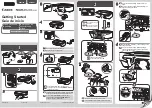
Chapter 2 Troubleshooting
2.1 Advancing Troubleshooting
2-5
2.1.4 Notes on Using FIP
1) If troubleshooting is still impossible, replace the major check parts listed at initial check and related
parts in sequence.
2) When using the FIP for troubleshooting, a normal PWBA MCU XFABK(B) and Drum/toner
cartridge may be required to isolate a fault.
3) Confirm the easy check items again at initial check in the FIP, and also check the major check
parts, component parts, and related parts.
4) Unless especially required, be sure to disconnect the power cable AC.
Do not absolutely touch the powered parts other than the required ones as the power cable
remains connected.
5) Unless especially specified, set "Turn on" in the FIP in online mode.
6) The connectors indicate the following contents:
“P/J12,CN12” The P/J12 and CN12 connectors are connected.
“P12,CN(P)12” Plug side when the P/J12 and CN12 connectors are disconnected (except when
they are directly attached to the board)
“J12,CN(J)12” Jack side when the P/J12 and CN12 connectors are disconnected (except when
they are directly attached to the board)
7) To measure the CN1-2PIN<=>P/J3-4PIN in the FIP, connect the plus side of the measuring
instrument to 2PIN of CN1, and the minus side to 4PIN of P/J3.
8) To measure CN1<=>P/J2 in the FIP, refer to Section 5, "Connection Wiring Diagram" in Chapter
6, and check all the pins between the CN1 and P/J2.
9) The P/J3-4PIN is necessarily set to SG (signal ground) or RTN (return).
Therefore, the FG (frame ground)/SG (signal ground) is a connection type.
Confirm that the FG and SG are powered exactly, and if necessary, connect the minus side to the
pin of another SG (or RTN) or frame (FG) instead of the P/J3-4PIN.
10) To measure the voltage with a connector on the PWBA MCU XFABK(B), use the pin of the plug on
the top of the connector or terminal side of the connector.
11) To measure the voltage, set the Drum/toner cartridge and Paper Cassette, close the top cover
(interlock switch is on), and turn the power on unless especially required.
12) The numeric values shown in the FIP are standard, and the approximate values are allowed.
13) To perform the check shown in the FIP, take care of the check work and necessarily removed
parts because there are no instructions.
14) "Replace" in action shown in the FIP indicates the parts assumed to be a fault source, and it
means that the operator should replace and check the parts and assembly parts (HIGH ASSY)
containing them.
15) The FIP provides a function that decides whether the diagnostic tool (maintenance tool) exists.
For troubleshooting, follow the instruction issued from the function.
Summary of Contents for DocuPrint 2050
Page 1: ...DocuPrint 2050 Service Manual 1st Edition KON001CA ...
Page 3: ...Company Name Department Name Telephone No Full Name Employee No ...
Page 5: ...Preface ...
Page 11: ...Chapter 1 Service Call Procedure ...
Page 19: ...Chapter 2 Troubleshooting ...
Page 85: ...Chapter 3 Image Quality Troubleshooting ...
Page 114: ...Chapter 4 Disassembly Assembly and Adjustment ...
Page 193: ...Chapter 5 Parts List ...
Page 207: ...Chapter 6 General ...
Page 243: ...Chapter 7 Wiring Data ...
Page 247: ...Chapter 7 Wiring Data 7 1 Connector P plug J jack 7 4 ...
Page 252: ...Chapter 7 Wiring Data 7 3 Wiring Diagram between Parts 7 9 Continued from the preceding page ...
Page 264: ...Chapter 10 Machine Overview ...
















































